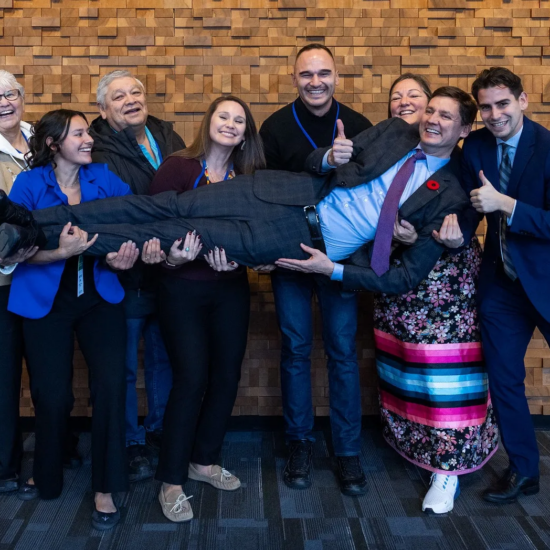
Bob Mackin
That photograph, obtained by theBreaker under freedom of information, is as much of a letter of understanding with Woodfibre LNG’s owner that Deputy Premier Rich Coleman is willing to show you before the May 9 provincial election.

Sukanto Tanoto (left) and Rich Coleman, holding documents the government refuses to release.
After the BC Liberals cancelled the fall 2016 sitting of the Legislature, Coleman — the co-chair of the BC Liberal re-election committee — went on an Oct. 16 to 21 junket to Southeast Asia. It included stops in Kuala Lumpur, to meet Petronas executives, and Singapore, to meet Indonesia-born, Royal Golden Eagle Group owner Sukanto Tanoto.
On Oct. 18, British Columbia’s natural gas minister posed for photographs with the billionaire behind the planned $1.6 billion Howe Sound LNG export plant. They also dined in luxury at the Corner House in Singapore. Coincidentally, the exclusive restaurant boasts a Whispering Corner.
Tanoto’s B.C.-based vice-president, Byng Giraud, joined Coleman and Premier Christy Clark for a hard hat photo op on Nov. 4 to announce the project would proceed after qualifying for subsidized electricity rates. That was the same day the BC Liberal convention began in Vancouver. No coincidence.
On Oct. 13, Coleman and Bill Bennett, the energy minister responsible for BC Hydro, spoke to the Cabinet Working Group on Woodfibre LNG. What they said is a secret. A footnote on their speaking notes says it is “protected by solicitor client privilege.” The government is the client and has the power to waive privilege. But it didn’t.

Coleman and Tanoto dined at the Corner House in Singapore, which boasts a “Whispering Corner.”
Those censored documents were released after theBreaker asked to see copies of the government’s business case and cost-benefit analysis for the eDrive program, which gives a discount to LNG plants that use BC Hydro electricity. An appeal has been filed with the Office of the Information and Privacy Commissioner.
Coleman and Bennett’s deputy ministers went back and forth with Giraud and his boss, Pacific Oil and Gas president Ratnesh Bedi, for almost two weeks on the letter of understanding and appendices that Coleman and Tanoto eventually signed.
Brian Hansen’s Oct. 5 letter to Bedi offers a clue, mentioning attached documents such as current versions of the electricity supply and load interconnection agreements with Woodfibre LNG and a link to redacted FortisBC Energy electricity supply and load interconnection agreements for its Tilbury LNG plant from June 2016.
The government also released a censored cabinet submission from last Nov. 1 about the eDrive program. Three days later, both eDrive and Woodfibre LNG’s decision to proceed were announced. Mayor Patricia Heintzman was not invited to the news conference at the former pulp and paper mill site. Chief Ian Campbell of the Squamish Nation stayed away.
The new eDrive rate is a $30 discount off the original $83.02 per megawatt-hour power rate the government had set for LNG plants. Eoin Finn of Woodfibre LNG foe My Sea to Sky estimated the eDrive rate would result in a $34 million-a-year subsidy to the plant, worth $860 million over 25 years.
Woodfibre LNG donated $79,500 to the BC Liberals from 2014 to 2016, including $5,000 just 11 days after the eDrive announcement. Giraud gave $48,964.36 since 2006. Two of Giraud’s 2016 Liberal donations ($10,225, Sept. 30 and $3,050, Nov. 30) bookended the period that included Coleman’s meeting with Tanoto and the eDrive decision. Natural gas supplier FortisBC and its predecessor, Terasen, donated $327,487.79 between 2005 and 2016.

Clark and Giraud, Nov. 4 (BC Gov)
In March 2016, the federal Liberal government gave conditional environmental approval for the plant. The company hired KBR for design, engineering, procurement and construction. As of Feb. 23, no job opportunities were posted on the Woodfibre LNG website.
An Oct. 6, 2016 briefing note for Coleman said design optimization had been completed and the next design phase would take eight to nine months.
“Woodfibre is not anticipating that it will enter into the permitting phase until early 2017, when they plan to submit their LNG facility permit application to the BC Oil and Gas Commission,” the briefing note said.
Giraud inked a 25-year supply deal in May 2016 with Guangzhou Gas Group beginning in 2020. The Chinese company has an option to buy up to 10% of the plant. The FortisBC pipeline to feed natural gas from Eagle Mountain to Woodfibre was conditionally approved in August 2016.
Woodfibre LNG asked the federal government Feb. 7 to extend its 25-year export licence to 40 years. Earlier that same week, it filed for an amendment to change from seawater cooling to the Squamish Nation-preferred air cooling.
Clark’s ambitious 2013 plan to build an LNG industry hit a snag with the global oil and gas glut. She originally vowed three plants would be built by 2020, but Woodfibre LNG could be the only one.
NGD 2017 70048 Coleman Tanoto by BobMackin on Scribd
Egm 2016 64736 Edrive Foi by BobMackin on Scribd











